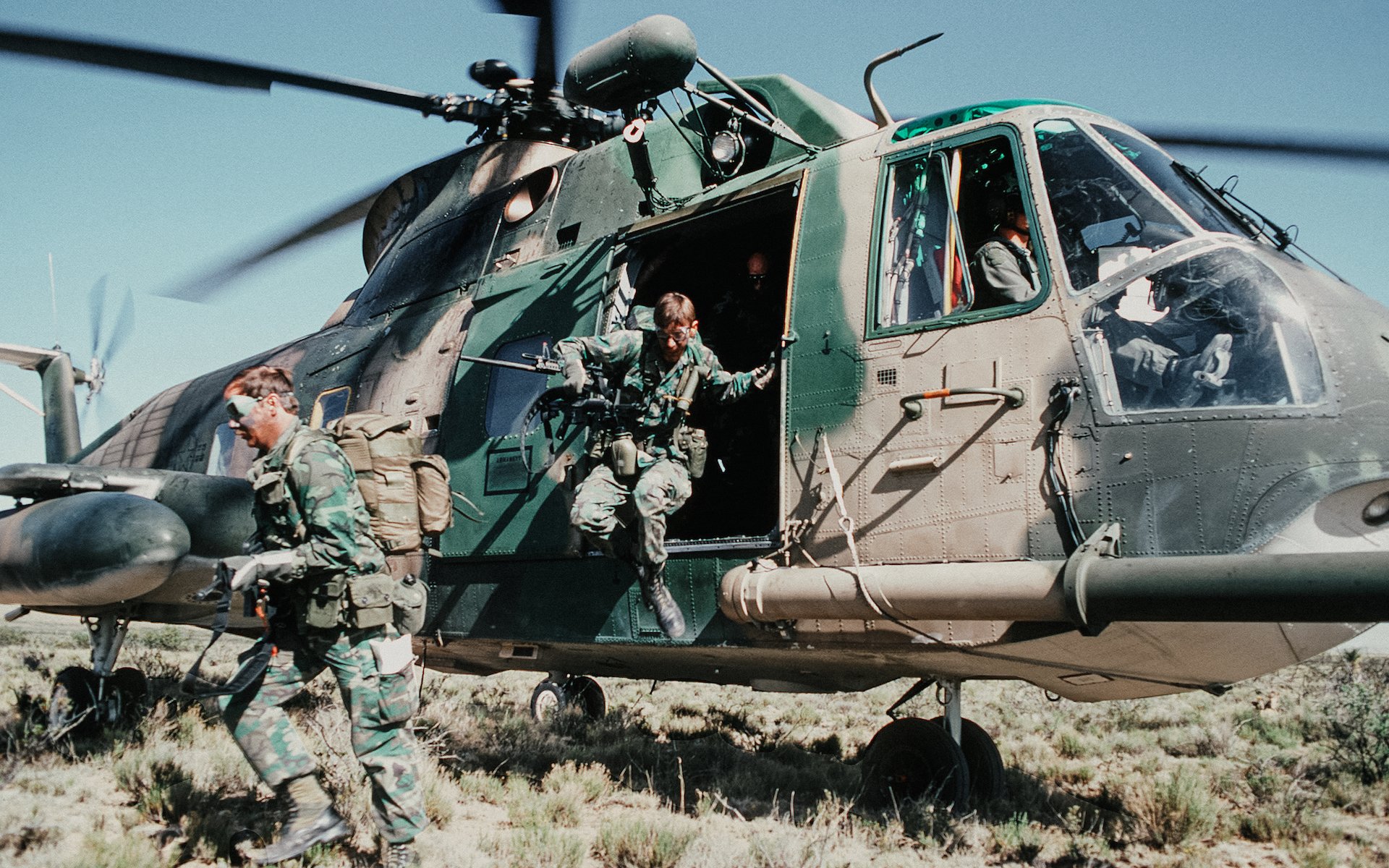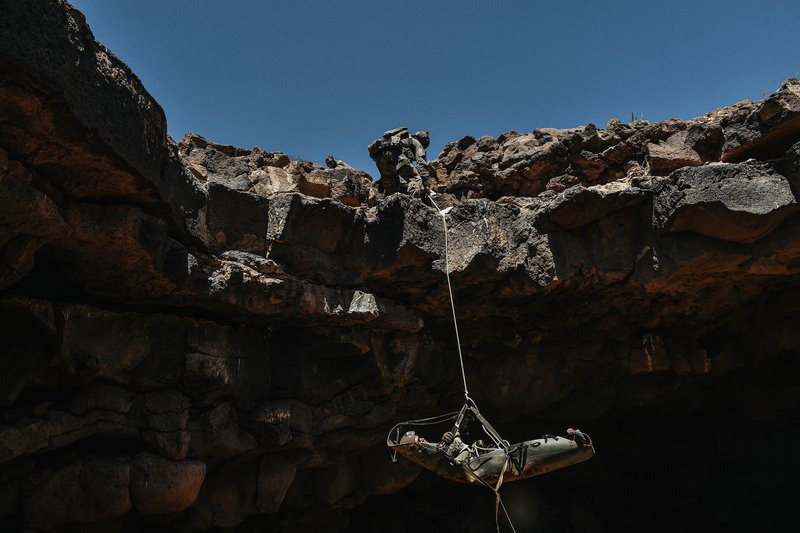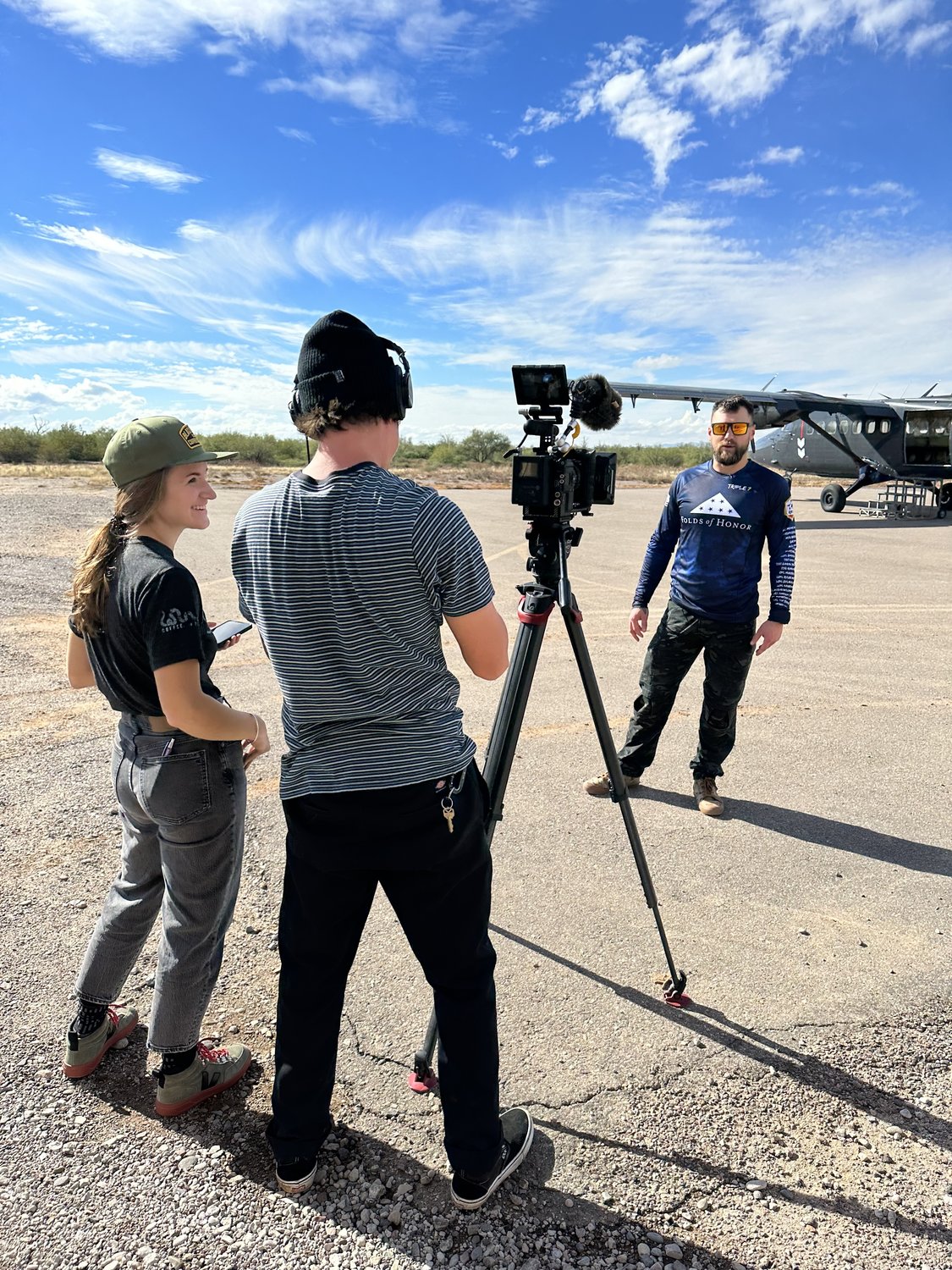‘That Others May Live’: What It Takes To Be an Air Force Pararescueman

Members of a pararescue team leave an HH-3E Jolly Green Giant helicopter to begin a search-and-rescue mission during Exercise Patriot Coyote in the 1990s. US Air Force photo by Staff Sgt. Steve McGill.
On Feb. 6, 1967, US Air Force Maj. Lucius Heiskell was shot down over the jungles of Vietnam while calling in airstrikes from his Cessna O-1 Bird Dog. Before long, two HH-3 Jolly Green Giant helicopters were circling over the vicinity of the crash site, trying to locate the American pilot. When the search proved fruitless, Air Force pararescueman Airman 2nd Class Duane Hackney went down the hoist and into the jungle on foot.
For hours, the lone PJ looked for Heiskell but found only boot prints. Then, bad weather rolled in, and Hackney was forced to return to his helicopter. But he was back in the jungle later that day. This time, he managed to locate Heiskell within minutes. The pair made it onto Jolly Green 05, relieved — but only for a moment.
As the helicopter ascended into the sky, it was struck by a barrage of 37mm anti-aircraft rounds. Moving quickly, Hackney grabbed his parachute and put it on Heiskell before finding a spare for himself. Then another salvo tore through the fuselage, blowing Hackney out of the aircraft. Falling, Hackney, who hadn’t had time to fully put on his chute, pulled the ripcord. The parachute barely deployed as he smashed through the jungle canopy.

An Air Force pararescueman from the Alaska National Guard, 212th Rescue Squadron, lands with the American flag on June 30, 2018, at Joint Base Elmendorf-Richardson in Anchorage, Alaska. US Air Force photo by Airman 1st Class Haley Stevens.
Ultimately, nobody but Hackney would survive the downing of Jolly Green 05. But it wasn’t for a lack of trying on his part. Throughout the rescue effort, he put Heiskell’s life before his own, braving the enemy-infested jungles and giving up his parachute to fulfill the PJ motto: “These Things We Do, That Others May Live.” As a result of his actions, he became the first living enlisted service member in history to receive the Air Force Cross. And to this day, his story serves as an example of why the pararescue career field exists: to ensure that no service member — no matter where they are — is ever left behind.
What Is an Air Force PJ?
The origins of pararescue trace back to 1943, when 20 people bailed out of a C-46 Commando transport plane over a jungle in Burma (now known as Myanmar). The crash site was so remote that the only way of reaching the survivors was by paradrop. Although the US military did not authorize parachute rescue operations at the time, flight surgeon Lt. Col. Don Flickinger and two medical corpsmen volunteered for the mission and successfully parachuted to the survivors. They tended to the wounded for a month until everyone could walk out of the jungle. Four years later, in July 1947, the US Army Air Forces established pararescue as an official career field.
Today, as members of Air Force Special Warfare, pararescuemen constitute an important cog in America’s elite special operations forces machine. Known as PJs for short — with the initials taken from the aircrew flight log designations “P” for parachutist and “J” for diver — they are relied upon to conduct the military’s toughest rescue missions. Historically, as Flickinger’s team did in Burma and Duane Hackney did in Vietnam, they have often operated in austere locations well behind enemy lines.

Air Force pararescue candidates participate in the water confidence introductory course on Aug. 16, 2011, at Lackland Air Force Base near San Antonio. US Air Force photo by Staff Sgt. Jonathan Snyder.
PJs are the only American service members specifically trained and equipped to conduct personnel recovery operations. Their unique skill set encompasses everything from skydiving and scuba diving to rock climbing and skiing. They are also — and perhaps most importantly — elite paramedics, capable of rendering lifesaving medical care, whether they be in the middle of the desert, in the jungle, or on the side of a snow-covered mountain.
Related: How ‘Charlie the PJ’ Became the Official Mascot of US Air Force Pararescue
How to Become an Air Force Pararescueman
Air Force pararescue is a relatively small career field, with roughly 500 airmen serving in the position at any given time. Historically, its training pipeline has had one of the highest attrition rates of all special operations jobs, with an average of approximately 20% of candidates in every rotation making the cut. Like all military career fields, pararescue is now open to both men and women. To date, however, only men have served in the job.
To become a PJ, new Air Force recruits must successfully navigate a 10-phase qualification process that takes about two years to complete and begins with basic training at Lackland Air Force Base near San Antonio. From there, PJ-wannabes proceed to the Special Warfare Candidate Course, also at Lackland, where they endure seven arduous weeks of running, rucking, and swimming. Those who pass the course then move on to the make-or-break month of Assessment and Selection, a grueling test of physical strength and endurance.

US Air Force special tactics airmen, Jordanian Armed Force Special Task Force, and Italian special operations forces pull a simulated casualty out of the Al Biadia Cave Complex during a personnel rescue mission for Eager Lion on May 13, 2017, in Mafraq Province, Jordan. US Air Force photo by Senior Airman Ryan Conroy.
Once they’ve been selected for the PJ career field, candidates start learning the pararescueman’s skill set. Over the next half-year or so, they are force-marched through a nonstop training schedule that includes Pre-Dive and Combat Dive school, Airborne school for static line parachuting, the Military Free-Fall Course for skydiving, and the infamous survival school known as SERE, an acronym for Survival, Evasion, Resistance, and Escape.
The second-to-last phase is a 39-week block of medical instruction, which prospective PJs must complete before finally finishing the pipeline with the 22-week Pararescue Apprentice Course. During the apprenticeship, candidates are expected to demonstrate proficiency in all of their newly acquired skills while under extreme pressure. The ones who do so successfully earn the coveted maroon beret that distinguishes PJs from all other airmen.
Related: How an Air Force Pararescue Team Recovered NASA Astronauts After Emergency Landing

On March 17, 1966, three US Air Force pararescuemen assist Gemini VIII astronauts Neil Armstrong and David Scott, who sit in their spacecraft while awaiting the recovery ship USS Leonard Mason. NASA photo.
Home Away From Home
With the initial training finally over, an active-duty pararescueman’s career can now get underway as a member of either a rescue or special tactics squadron. Rescue squadrons focus on the career field’s original mission: rescuing and recovering downed and injured aircrew members behind enemy lines. During the Global War on Terror, rescue squadrons also conducted casualty evacuation, or CASEVAC, missions, often flying into active firefights to extract and treat wounded GIs.
Meanwhile, PJs assigned to special tactics squadrons are usually attached to special operations teams from other branches, such as the Army Green Berets and Navy SEALs. They often work in those assignments alongside airmen from other Air Force special operations career fields, including Combat Control (CCT), Special Reconnaissance (SR), and Tactical Air Control Party (TACP). The PJs not only provide on-the-ground medical care, but also have wide-ranging expertise. As a jack-of-all-trades, a PJ might find himself cutting into a vehicle to rescue a trapped teammate or rappelling down the side of a cliff to retrieve an operator who lost his footing.
Regardless of which type of squadron a PJ is assigned to, he can expect to be involved in some of the US military’s toughest missions, rescuing service members from the places no one else is able to go.
Read Next: Sua Sponte: The Fighting Spirit of the 75th Ranger Regiment

Jenna Biter is a staff writer at Coffee or Die Magazine. She has a master’s degree in national security and is a Russian language student. When she’s not writing, Jenna can be found reading classics, running, or learning new things, like the constellations in the night sky. Her husband is on active duty in the US military. Know a good story about national security or the military? Email Jenna.
BRCC and Bad Moon Print Press team up for an exclusive, limited-edition T-shirt design!
BRCC partners with Team Room Design for an exclusive T-shirt release!
Thirty Seconds Out has partnered with BRCC for an exclusive shirt design invoking the God of Winter.
Lucas O'Hara of Grizzly Forge has teamed up with BRCC for a badass, exclusive Shirt Club T-shirt design featuring his most popular knife and tiomahawk.
Coffee or Die sits down with one of the graphic designers behind Black Rifle Coffee's signature look and vibe.
Biden will award the Medal of Honor to a Vietnam War Army helicopter pilot who risked his life to save a reconnaissance team from almost certain death.
Ever wonder how much Jack Mandaville would f*ck sh*t up if he went back in time? The American Revolution didn't even see him coming.
A nearly 200-year-old West Point time capsule that at first appeared to yield little more than dust contains hidden treasure, the US Military Academy said.












